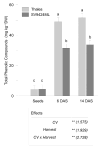New Insights into Sprout Production from Melon (Cucumis melo L. var. reticulatus) Seeds as By-Product of Fruit Processing
- PMID: 40647905
- PMCID: PMC12252063
- DOI: 10.3390/plants14131896
New Insights into Sprout Production from Melon (Cucumis melo L. var. reticulatus) Seeds as By-Product of Fruit Processing
Abstract
Melon is a valuable crop that generates significant by-products during consumption and processing. Among these, seeds are rich in phenolic compounds and might be used to produce sprouts with increased content of these bioactive substances. This study evaluated phenolic compounds (PhCs) in sprouts of two melon cultivars, Thales and SV9424ML, obtained from seeds having different germination speeds, thus harvested at 6 and 14 days after sowing (DAS). A factorial combination of cultivar and harvest time was tested in a completely randomized design with four replicates. Thales produced more ready-to-eat sprouts at 6 DAS than SV9424ML (64.0% vs. 46.7%). Sprouting significantly increased total PhCs content, particularly flavonoids, with Thales showing higher values than SV9424ML (50.2 vs. 32.6 mg kg-1 DW). Phenolic profiles significantly varied among cultivars and harvests. Sprouts at 6 DAS had more total hydroxybenzoic acids and flavonoids, while 14 DAS sprouts were richer in hydroxycinnamic acids. Significant differences between harvest dates were observed in the concentrations of protocatechuic, vanillic (VanA), p-coumaric (p-CouA), ferulic (FerA) acids, and orientin (Ori) for Thales, and of VanA, p-CouA, FerA, and Ori for SV9424ML. Results are encouraging, but future investigations are essential to understand whether these sprouts can be suitable for fresh consumption, food supplements, or phytochemical extraction.
Keywords: flavonoids; germination; hydroxybenzoic acids; hydroxycinnamic acids; polyphenol.
Conflict of interest statement
The authors declare no conflicts of interest.
Figures



Similar articles
-
Salt-Induced Changes in the Phenolic Content of Melon F2 Offspring Sprouts Obtained from Fruit Deseeding.Foods. 2025 Jun 25;14(13):2242. doi: 10.3390/foods14132242. Foods. 2025. PMID: 40646994 Free PMC article.
-
The Black Book of Psychotropic Dosing and Monitoring.Psychopharmacol Bull. 2024 Jul 8;54(3):8-59. Psychopharmacol Bull. 2024. PMID: 38993656 Free PMC article. Review.
-
Sexual Harassment and Prevention Training.2024 Mar 29. In: StatPearls [Internet]. Treasure Island (FL): StatPearls Publishing; 2025 Jan–. 2024 Mar 29. In: StatPearls [Internet]. Treasure Island (FL): StatPearls Publishing; 2025 Jan–. PMID: 36508513 Free Books & Documents.
-
Sertindole for schizophrenia.Cochrane Database Syst Rev. 2005 Jul 20;2005(3):CD001715. doi: 10.1002/14651858.CD001715.pub2. Cochrane Database Syst Rev. 2005. PMID: 16034864 Free PMC article.
-
A rapid and systematic review of the clinical effectiveness and cost-effectiveness of paclitaxel, docetaxel, gemcitabine and vinorelbine in non-small-cell lung cancer.Health Technol Assess. 2001;5(32):1-195. doi: 10.3310/hta5320. Health Technol Assess. 2001. PMID: 12065068
References
-
- Okuthe G. Valorizing fruit and vegetable waste: The untapped potential for entrepreneurship in sub-saharan Africa—A systematic review. Recycling. 2024;9:40. doi: 10.3390/recycling9030040. - DOI
-
- de Medeiros L.D.G., de Carvalho L.B.A., Freitas E.P.S., Porto D.L., Aragão C.F.S., de Sousa Júnior F.C., da Silva Chaves Damasceno K.S.F., de Assis C.F., Araújo Morais A.H., Passos T.S. Alternative flours from pulp melons (Cucumis melo L.): Seasonality influence on physical, chemical, technological parameters, and utilization in bakery product. Heliyon. 2024;10:e29609. doi: 10.1016/j.heliyon.2024.e29609. - DOI - PMC - PubMed
LinkOut - more resources
Full Text Sources

